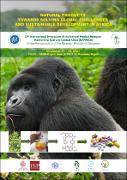| dc.identifier.citation | Oloya, B, Namukobe, J. et al (2021). Antimycobacterial activity, acute toxicity, and characterisation of compounds from selected medicinal plants used in the treatment of Tuberculosis in Uganda. In Proceedings of the 19th International Symposium of the Natural Product Research Network for East and Central Africa (NAPRECA) Under the auspicious of the Rwandan Ministry of Education. Held from 23 – 25 November 2021 in Kigali, Rwanda. (pp. 21–22) | en_US |
| dc.description.abstract | Tuberculosis (TB) is one of the leading causes of death globally, and the rise in drug-resistant forms of TB has become a significant threat (WHO, 2020). Subsequently, it is crucial to explore new, effective and safe anti-TB agents. Several plant species are used in traditional medicine for the treatment of TB in Africa. In Uganda, Acacia hockii, Albizia coriaria, Combretum molle, Warburgia ugandensis, and Zanthoxylum leprieurii are among the plant species used locally to treat tuberculosis, and they could have antimycobacterial compounds that may justify their traditional use but without scientific validation of their bioactivity and toxicity (Anywar et al., 2020; Bunalema et al., 2014; Muthee et al., 2011; Tabuti et al., 2010). This study aimed to conduct antimycobacterial activity and acute toxicity of the selected plant species’ crude extracts and isolate compounds from the stem bark of Z. leprieurii. The aqueous and methanol/dichloromethane (DCM) (1:1) extracts of each of the selected plant species and the isolated compounds were tested for antimycobacterial activity using microplate alamar blue assay (Lawal et al., 2011). For acute toxicity, a single dose (2000 mg/kg) of the aqueous extracts was orally administered to each adult female Winstar albino rat and then observed for 14 days (Lipnick et al., 1995; OECD, 2008). At the end of the experiment, blood samples were collected for haematological and biochemical analyses, while tissue samples from vital organs were collected for histopathological analysis. Isolation and purification of the compounds from the Z. leprieurii stem bark extract were performed using repeated column chromatography. Structure elucidation of the compounds was carried out using spectroscopic methods and by comparison with literature data. Aqueous extracts showed moderate-weak activity against the susceptible (H37Rv) TB strain and weak activity against the multidrug-resistant (MDR) TB strain. Methanol/DCM extracts showed significant-moderate activity against the susceptible (H37Rv) TB strain and moderate-weak activity against the MDR TB strain. After the acute toxicity tests, one mortality and significant lesions in the examined organs following histopathological analyses were recorded from the A. coriaria treated group. Still, the LD50 of all the extracts was estimated to be above 2000 mg/kg. Lupeol, sesamin, trans-fagaramide, arnottianamide, (S)-marmesinin, and hesperidin were isolated from the chloroform/methanol (1:1) extract of Z. leprieurii stem bark, and trans-Fagaramide showed significant antimycobacterial activity against the susceptible (H37Rv) TB strain (Oloya et al., 2021). A. hockii methanol/DCM extract had significant antimycobacterial activity against the susceptible (H37Rv) TB strain, and the methanol/DCM extracts of all the other selected plants had good antimycobacterial activity. The selected plant extracts except A. coriaria exhibited low acute toxicity levels and could be safe for formulations into herbal products. trans-Fagaramide may present a vital template in pursuit of novel and highly effective TB drugs. | en_US |

